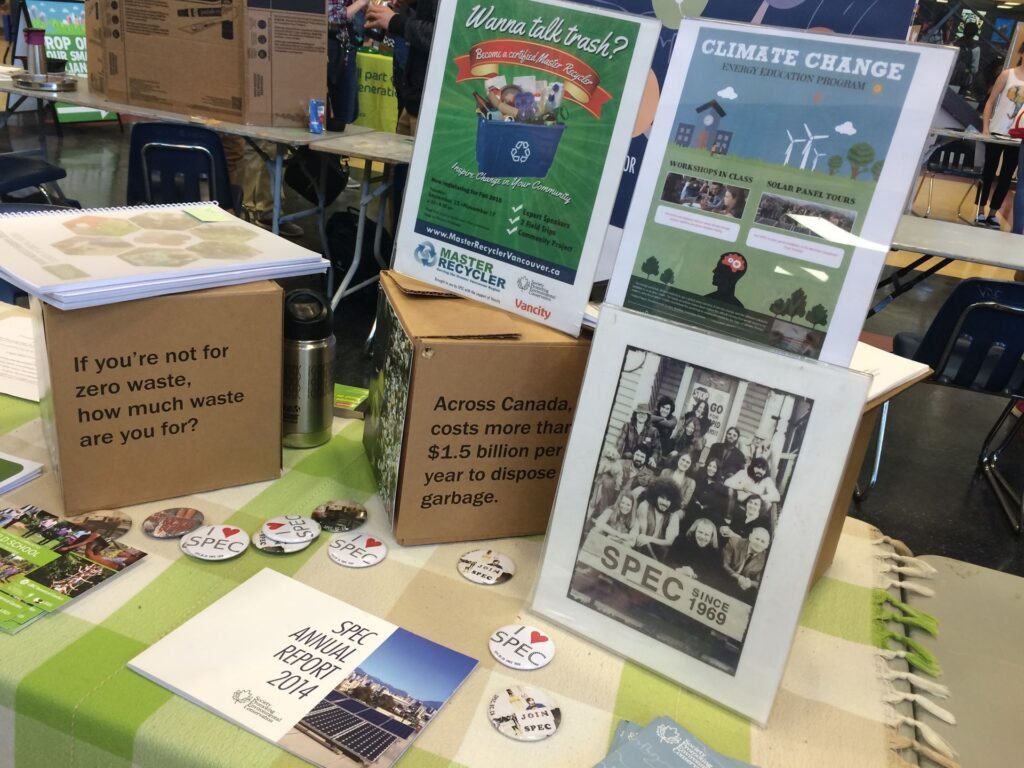Written by SPEC Intern Jamie

As an intern at SPEC, I´ve received so much information about everything environmental. And there is something important I would like to share with you. Monsters are real.
For this year’s 2016 Earth Day Celebration, four of us (SPEC volunteers Carol, Hisayo, and Shona) took part in two events. The first one was at Sir Winston Churchill Secondary School.
All over the world such events make us more aware of what is going on this planet of ours. How does the Earth feel today? Good? Bad? Does it have a stuffy nose and watery eyes, or is it healthy as a nut?, as we say in Swedish.
Lunch was a good example of how a whole school can reduce their waste. Participants got more than one reminder before the event to bring our own plate, utensils and a cup. They provided the food, but we would provide no waste. And people did that. The food was vegan and gluten-free, so I was happy, as I could enjoy it as well.
A few minutes past twelve, suddenly the lunch room was overwhelmed by the noise of students flooding in through the doors, and then the event started.
One thing I noticed was that the students too had their own jars and forks with them. Most of them had thermoses instead of plastic bottles or paper cups. I was really happy to see that.
At one display table, students made their own signs promoting more bicycle usage, as well as an experiment. It was two see-through water bottles. Both had water in them with a sign that said: Do you taste the difference? One was bought bottled water and the other was tap water—the water you get directly from your faucet. I loved the student’s creativity and cleverness.
By the way, do you know how big the state of Texas is? Now imagine it twice the size, made of plastic waste, and put it in the ocean. Remember, I told you that monsters are real.
In one study, it found that the average family uses around 500 plastic bags a year. To show just how much plastic that is, SPEC volunteers took 500 plastic bags and made a monster out of it. Hisayo had the great honour to representing trash that day.
The second event was at Laura Secord Elementary School where we talked trash. Lit-t-erally.
As the students gathered closer to the board and the projector screen lit up, all eyes focused on the topic of waste — the waste we produce at home, in school, at work, and when we go out. That waste has to end up somewhere, right? This was the topic of the workshop. What happens to our waste?
Here is one story that I would like to share with you. In 1986, there was a ship named Khian Sea that left Philadelphia with toxic ash because the city didn’t want it, and neither did New Jersey. Or any other city for that matter. So Khian Sea started to sail to different countries and places to dump the ash somewhere, and no one wanted it. Greenpeace writes in their report back in June 2010 this: “Two years, three names, four continents, and 11 countries later, the troublesome cargo was still on board. Then, somewhere in the Indian Ocean between Singapore and Sri Lanka all the ash disappeared. When questioned about this, the crew had no comment except that it was all gone.”
And it wasn’t the only one. In the report, you can also read about other ships from the Italian hub, the Mediterranean area and Africa.
Before I depart back to Sweden, I’d like to share this thought with you. During my intern-ship, I’ve learned that not everyone needs to be in love with the Earth, but it is important to remember that we all enjoy living here. Right?
—SPEC Intern Jamie